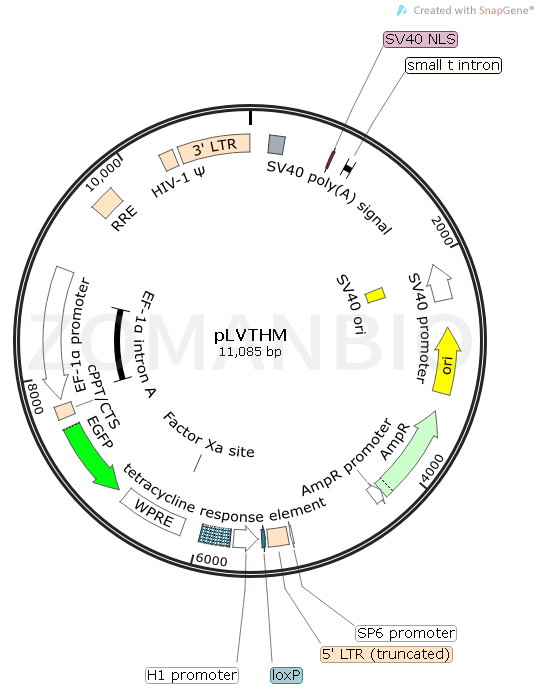■ 基本信息
启动子: | H1 |
复制子: | pUC |
终止子: | SV40 poly(A) signal,bGH poly(A) signal |
质粒分类: | 病毒系列,慢病毒干扰载体 |
质粒大小: | 11085bp |
原核抗性: | Amp |
克隆菌株: | Stbl3 |
培养条件: | 37度 |
表达宿主: | 哺乳细胞 |
诱导方式: | 无须诱导,瞬时表达 |
5'测序引物: | 根据序列设计引物 |
3'测序引物: | WPRE-R:CATAGCGTAAAAGGAGCAACA |
■ 质粒属性
质粒宿主: | 哺乳细胞,慢病毒 |
质粒用途: | 基因沉默 |
片段类型: | shRNA |
片段物种: |
|
原核抗性: | Amp |
真核抗性: |
|
荧光标记: | 绿色
|
■ 质粒简介
pLVTHM allows for direct cloning of shRNAs into the lentiviral vectors and replaces the old pLVTH system from Trono lab. pLVTHM is similar to pLVTH, but contains a 3bp substitution that generates a unique MluI site for direct cloning of an shRNA into MluI-ClaI. Please note that there is an additional ClaI site in this vector that is blocked by Dam methylation . The plasmid needs to be grown in a Dam+ bacterial strain in order to use ClaI for cloning. Note that ClaI has lower salt concentration requirements than MluI. One way to handle this is to digest with ClaI for 45 minutes, followed by addition of diluted MluI buffer and MluI, then incubation for 90 more minutes. Be sure not to use a large amount of vector (1.7 ug to 2.5 ug is known to work). Also, if your shRNA is already in pSUPER (or another plasmid under the control of the PolIII promoter) you may use the EcoRI-ClaI sites to replace the H1 promoter in pLVTHM with the H1-shRNA cassette from pSUPER (or another plasmid).
■ 质粒图谱

■ 质粒序列
质粒序列请下载: ZK822pLVTHM慢病毒干扰质粒.txt
ZK822pLVTHM慢病毒干扰质粒.txt



